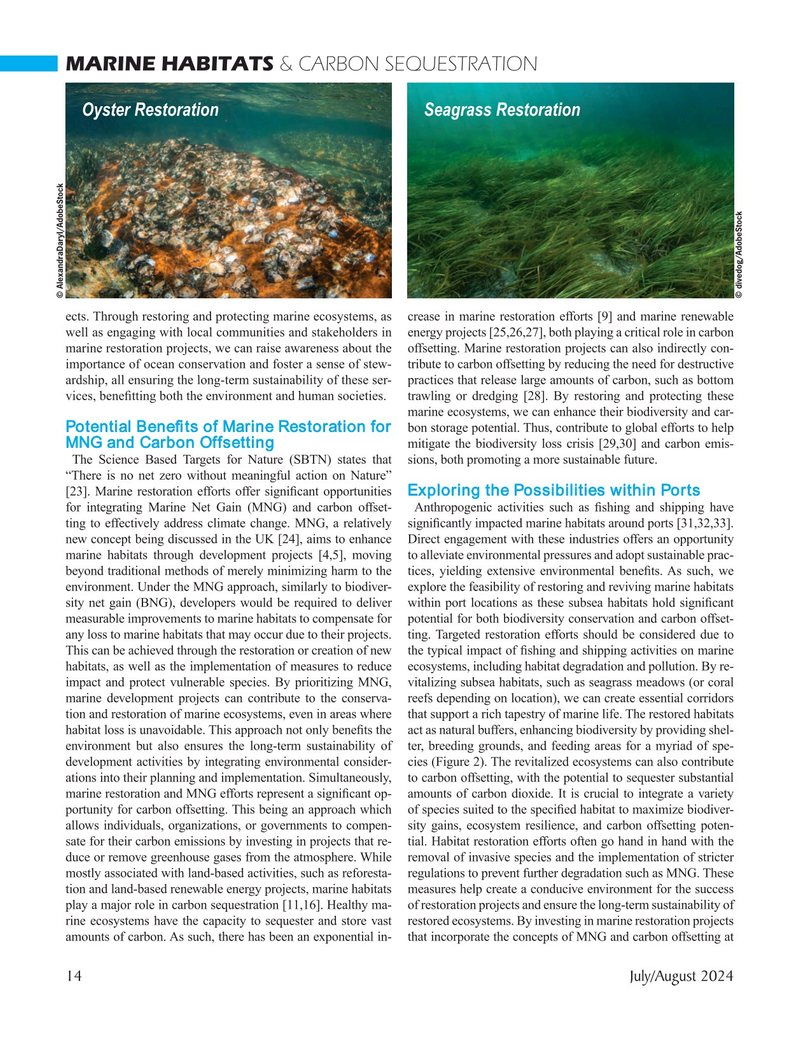
Page 14: of Marine Technology Magazine (July 2024)
Read this page in Pdf, Flash or Html5 edition of July 2024 Marine Technology Magazine
MARINE HABITATS & CARBON SEQUESTRATION
Oyster Restoration Seagrass Restoration © AlexandraDaryl/AdobeStock © divedog/AdobeStock ects. Through restoring and protecting marine ecosystems, as crease in marine restoration efforts [9] and marine renewable well as engaging with local communities and stakeholders in energy projects [25,26,27], both playing a critical role in carbon marine restoration projects, we can raise awareness about the offsetting. Marine restoration projects can also indirectly con- importance of ocean conservation and foster a sense of stew- tribute to carbon offsetting by reducing the need for destructive ardship, all ensuring the long-term sustainability of these ser- practices that release large amounts of carbon, such as bottom vices, bene? tting both the environment and human societies. trawling or dredging [28]. By restoring and protecting these marine ecosystems, we can enhance their biodiversity and car-
Potential Bene? ts of Marine Restoration for bon storage potential. Thus, contribute to global efforts to help
MNG and Carbon Offsetting mitigate the biodiversity loss crisis [29,30] and carbon emis-
The Science Based Targets for Nature (SBTN) states that sions, both promoting a more sustainable future.
“There is no net zero without meaningful action on Nature” [23]. Marine restoration efforts offer signi? cant opportunities Exploring the Possibilities within Ports for integrating Marine Net Gain (MNG) and carbon offset- Anthropogenic activities such as ? shing and shipping have ting to effectively address climate change. MNG, a relatively signi? cantly impacted marine habitats around ports [31,32,33]. new concept being discussed in the UK [24], aims to enhance Direct engagement with these industries offers an opportunity marine habitats through development projects [4,5], moving to alleviate environmental pressures and adopt sustainable prac- beyond traditional methods of merely minimizing harm to the tices, yielding extensive environmental bene? ts. As such, we environment. Under the MNG approach, similarly to biodiver- explore the feasibility of restoring and reviving marine habitats sity net gain (BNG), developers would be required to deliver within port locations as these subsea habitats hold signi? cant measurable improvements to marine habitats to compensate for potential for both biodiversity conservation and carbon offset- any loss to marine habitats that may occur due to their projects. ting. Targeted restoration efforts should be considered due to
This can be achieved through the restoration or creation of new the typical impact of ? shing and shipping activities on marine habitats, as well as the implementation of measures to reduce ecosystems, including habitat degradation and pollution. By re- impact and protect vulnerable species. By prioritizing MNG, vitalizing subsea habitats, such as seagrass meadows (or coral marine development projects can contribute to the conserva- reefs depending on location), we can create essential corridors tion and restoration of marine ecosystems, even in areas where that support a rich tapestry of marine life. The restored habitats habitat loss is unavoidable. This approach not only bene? ts the act as natural buffers, enhancing biodiversity by providing shel- environment but also ensures the long-term sustainability of ter, breeding grounds, and feeding areas for a myriad of spe- development activities by integrating environmental consider- cies (Figure 2). The revitalized ecosystems can also contribute ations into their planning and implementation. Simultaneously, to carbon offsetting, with the potential to sequester substantial marine restoration and MNG efforts represent a signi? cant op- amounts of carbon dioxide. It is crucial to integrate a variety portunity for carbon offsetting. This being an approach which of species suited to the speci? ed habitat to maximize biodiver- allows individuals, organizations, or governments to compen- sity gains, ecosystem resilience, and carbon offsetting poten- sate for their carbon emissions by investing in projects that re- tial. Habitat restoration efforts often go hand in hand with the duce or remove greenhouse gases from the atmosphere. While removal of invasive species and the implementation of stricter mostly associated with land-based activities, such as reforesta- regulations to prevent further degradation such as MNG. These tion and land-based renewable energy projects, marine habitats measures help create a conducive environment for the success play a major role in carbon sequestration [11,16]. Healthy ma- of restoration projects and ensure the long-term sustainability of rine ecosystems have the capacity to sequester and store vast restored ecosystems. By investing in marine restoration projects amounts of carbon. As such, there has been an exponential in- that incorporate the concepts of MNG and carbon offsetting at 14 July/August 2024
MTR #5 (1-17).indd 14 7/23/2024 1:42:13 PM

 13
13

 15
15
